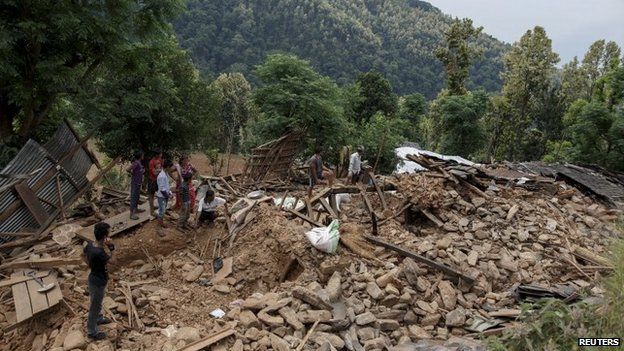Reuters is reporti ng today: “People stranded in remote villages and towns across Nepal were still waiting for aid and relief to arrive on Tuesday, four days after a devastating earthquake destroyed buildings and roads and killed more than 4,600 people.”
ng today: “People stranded in remote villages and towns across Nepal were still waiting for aid and relief to arrive on Tuesday, four days after a devastating earthquake destroyed buildings and roads and killed more than 4,600 people.”
ERIC LeCOMPTE, via Sophia Har, sophia at jubileeusa.org
LeCompte is executive director of the religious development coalition, Jubilee USA Network. The group put out the statement: “Aftershocks Pummel Highly Indebted Nepal: Poor Country Spends 217 Million Annually on Debt Payments.”
MARY DesCHENE, mdeschen at wustl.edu
DesChene is an anthropologist and is the co-founder and former editor of the journal Studies in Nepali History and Society. A research associate at Washington University in St. Louis, she is fluent in Nepali and has been conducting research in Nepal for more than three decades. From 2007 to 2009 she worked in Nepal’s Ministry of Health as policy advisor for social inclusion in the national health system. She has lived and worked in hill areas similar to the epicenter region as well as in the Kathmandu Valley. She is in contact with people from the government and non-government sector who are actively engaged in the recovery operation.
DesChene said today: “The immediate situation is obviously dire and a great deal of emergency relief aid is needed. However, Nepal has a great deal of expertise in critical sectors such as health, power infrastructure, etc. But with no local elected government since 2002, and a weak central government at present, the great challenge is going to be coordination of both foreign and domestic efforts for effective recovery. Just as the quake hit, in the political arena the process of writing a new constitution was at an impasse, and on the health front, the national health system was struggling to cope with a swine flu outbreak. In normal times, the health system is insufficient for the regular needs of the population.
“The Kathmandu Valley, with a population of 4 million, already had severe water and power shortages. Government response to a recent massive landslide indicates that the most affected rural areas are going to have to rebuild largely on their own. Besides immediate relief, there are critical steps that need to be taken prior to the monsoon. A massive rainwater harvesting initiative is needed in the Kathmandu Valley for example, to avoid cholera and typhoid epidemics. Such initiatives represent opportunity amid tragedy.
“Some of the worst kinds of unsustainable ‘development’ that having been turning Kathmandu into one of the most unhealthy cities in the world, may be able to be reversed in the rebuilding. Thus even during the unfolding tragedy, it is not too soon to raise serious questions about appropriate aid for the longer term rebuilding. In normal times the country’s planning processes and policy-making are heavily interfered with by the aid agencies. Despite talk to the contrary, aid agencies operate in such a way as to make themselves permanent, and government permanently dependent.
“Among the first acts of all the major aid agencies ought to be debt cancellation, freeing up government funds for rebuilding. The IMF has a new program under which Nepal should qualify for cancellation of its $54 million debt due to the scale of the disaster. A strong call for all major lenders to follow suit is important right now.”